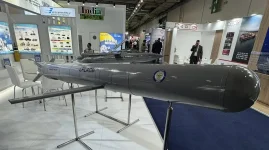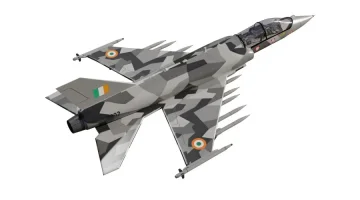India's indigenous artillery capabilities are poised for a major advancement as the Defence Research and Development Organisation (DRDO) prepares to begin trials for the Pinaka Mk3.
This advanced guided rocket system, boasting a range of 120 kilometres, has been developed by DRDO's Armament Research and Development Establishment (ARDE) along with other associated laboratories.
The Pinaka Mk3 is engineered to deliver highly accurate strikes with increased firepower over longer distances.
The system is now ready for combined developmental and user trials, with initial pre-production units already manufactured by private sector partner Solar Industries India Ltd.
These trials, set to commence shortly, are designed to meet production-ready standards and aim to accelerate the Pinaka Mk3's integration into the Indian Army. This development is expected to significantly bolster India's strategic deterrence capabilities within the region.
Unveiled at a defence exhibition in Hyderabad earlier this year, the Pinaka Mk3 marks a substantial improvement over its predecessors: the Pinaka Mk1 (40 km range), Mk2 (60-90 km range), and the Guided Pinaka (75-90 km range).
The new variant reportedly features a 300mm calibre, an increase from the 214mm calibre of earlier versions. This allows the Pinaka Mk3 to carry a larger 250 kg warhead and achieve its maximum 120 km range, placing it in competition with systems such as Russia’s Smerch Multiple Barrel Rocket Launcher (MBRL) (90 km) and China’s PHL-03 (70-130 km).
The larger diameter facilitates more propellant and accommodates advanced guidance systems, ensuring high precision and greater destructive power against critical targets like enemy command posts, fortified bunkers, and logistics centres.
At the heart of its accuracy is a sophisticated guidance, navigation, and control (GNC) kit, developed by DRDO’s Research Centre Imarat (RCI). This technology enables the Pinaka Mk3 to execute precise strikes even in difficult environments, such as the mountainous terrains found in Ladakh and Kargil.
Importantly, the rockets are compatible with existing Pinaka launchers, which will help reduce infrastructure costs and allow for smooth incorporation into the Indian Army’s current artillery formations.
Each Pinaka launcher can carry two pods; the guided variant can hold eight rockets, factoring in additional electronic components, and is capable of firing a full salvo in just 44 seconds to neutralise an area measuring approximately 700 by 500 metres.
Solar Industries India Ltd., operating through its subsidiary Economic Explosives Ltd. (EEL), has become a significant contributor to the production of Pinaka rockets under a Transfer of Technology (ToT) agreement with DRDO.
The company has supplied the initial pre-production units of the Pinaka Mk3, which were showcased at the Hyderabad exhibition. These units, built to final production specifications, highlight the effective partnership between DRDO and private industry, supporting India's 'Aatmanirbhar Bharat' (self-reliant India) initiative.
Solar Industries' established success with previous Pinaka versions, including the triumphant trials of the Enhanced Pinaka Mk1 and Guided Pinaka in 2020 and 2021, demonstrates its capacity to produce high-quality munitions on a large scale.
The forthcoming Pinaka Mk3 evaluations will merge developmental and user trials, a strategy chosen to speed up the system's deployment with the Indian Army. This combined approach signifies the system's advanced stage of development and the strong belief in its production-ready design.
The trials, due to start soon, will assess key performance indicators including range, accuracy, consistency, and rate of fire during salvo engagements.
According to DRDO sources, twelve rockets from each manufacturing agency (Economic Explosives Ltd. and Munitions India Limited) will be fired from two upgraded Pinaka launchers currently in service, across various field firing ranges. These tests will also examine the system's compatibility with existing command-and-control networks and its effectiveness in simulated combat conditions.
The decision for combined trials is rooted in the successful validation of earlier Pinaka models, notably the Guided Pinaka, which finished its Provisional Staff Qualitative Requirements (PSQR) trials in November 2024.
These trials confirmed the Guided Pinaka's ability to hit targets beyond 75 km with a Circular Error Probable (CEP) – a measure of accuracy – of less than 10 metres. This is a vast improvement over the unguided Pinaka Mk1’s accuracy of around 500 metres.
The Pinaka Mk3 improves upon this foundation by integrating advanced technologies such as a wraparound microstrip antenna and a laser-gyro navigation system, reportedly from Sagem (now Safran Electronics & Defense), to achieve even greater precision at its extended range.
The creation of the Pinaka Mk3 is a direct strategic move in response to the changing security situation in South Asia. The deployment of long-range rocket systems by neighbouring countries, including China's 300mm PHL-03 launchers near the Line of Actual Control (LAC) and Pakistan’s A-100 systems (120 km range), has emphasized the need for India to bolster its own long-range artillery capabilities.
The Indian Army’s approval in 2021 for Pinaka variants with ranges of 120 km and 300 km reflects this requirement, with the Pinaka Mk3 offering a cost-effective, domestically produced alternative to imported systems like the Smerch MBRL.
With its 120 km range and 250 kg warhead, the Pinaka Mk3 is well-suited for both widespread area attacks (saturation strikes) and precise targeting of critical infrastructure and high-value assets deep within enemy lines. Its compatibility with current launchers allows for quick deployment, and its indigenous development simplifies logistics and maintenance.
The advancement of the Pinaka Mk3 is also in step with India's wider defence modernization goals. DRDO is reportedly exploring a future variant with a range of 200-300 km to counter systems like China’s PHL-16, which could potentially classify the Pinaka system as a short-range ballistic missile.








